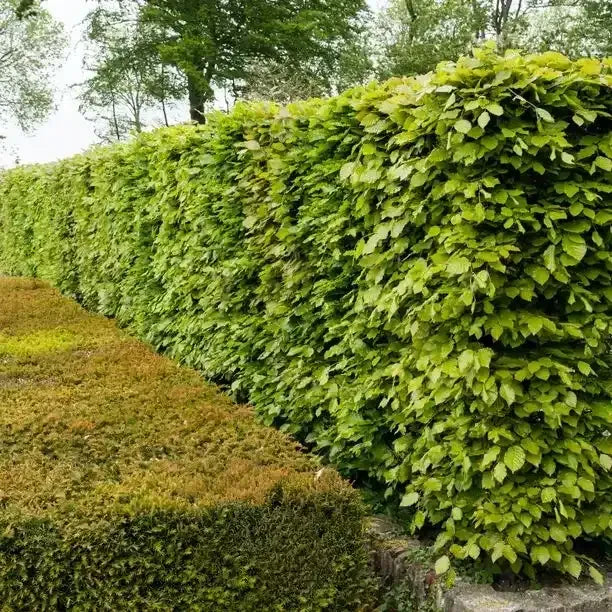Yew is the King of Hedges for good reason, but it grows steadily rather than vigorously, so a new Yew hedge takes a bit more time to reach the desired size.
If it suits your budget, it makes sense to buy large Yew plants delivered with a rootball, rather than bareroot smaller size plants.
Spacing Bareroot Vs Rootballed Yew
- For a dense yew hedge, we recommend 3 bareroot plants per metre, 33cm apart.
- Yew rootballs should be about 33cm wide, but might need some massaging into place to fit exactly 3 per metre.
1. Rootballed plants are heavy!
As much as 30kg, which is over the workplace safe lifting limit for one person:
- They are delivered in one or more pallets.
- Once unloaded, a sack truck or a strong wheelbarrow is very useful.
- Planting really is a two-person job: if you have to do it alone, go slowly and lift using your leg muscles.
2. Yew establishes best in prepared soil
- Take out a trench 30cm (12″) deep and about 45cm (18″) wide.
- Improve the soil you excavate by removing weeds, roots, rubbish, larger stones and buried treasure. Break up the clods and incorporate some well-rotted organic matter – no more than 25% by volume.
If you are planting in heavy clay, add nothing to the trench. Instead, use that organic matter as mulch over the soil surface after planting.
- Fork over the bottom of the trench to make sure there is no compacted soil – especially important if you used a digger
- Beware of heavy clay in areas where water collects. You will need to deal with the drainage problem clay presents before planting almost any hedge, except for water loving plants like Willow, Hazel, and Dogwood. Almost any other hedging will die in standing water, which is what happens if you dig a trench in clay. Fixing the problem may require professional advice and is not the subject of this advice – just be aware of the danger.
3. Stand the rootballs in the trench
- Leave the jute sacking tied around the rootballs intact. It will rot away quickly.
- Depending on plant size, space your plants at about 60 cm apart. More if they are overcrowded.
- Yew hedging is formal, so it pays to spend time getting your lines straight and the spacing even. Unless you have the eye of a pyramid builder, use string stretched between canes to make sure you are planting straight. Check the measurements between the individual plants. No shame in double-checking either.
- Rootballs are not identical in size, so some will need to be lifted by adding some soil underneath, while others may need a bit of soil removed from the trench floor beneath
4. Plant your hedge
- Gently water the rootballs. Just enough to make sure the jute is wet.
- Return the soil around the plants, making sure that they remain well-spaced, upright and in line.
- Firm the soil as the level rises, and make sure that when finished, the jute is completely covered.
- Because of the size of the rootballs and the organic matter you added to the soil from the trench, you should have some planting mixture left over when you have finished. Don’t try to use it all up on your Yew. Put it to one side and use it to raise the soil level if there is any sinkage over the 4-6 weeks following planting. When that is done, use it elsewhere in the garden instead of drowning your plants.
- Talking of drowning – water really well when planting is finished, and make sure the bed does not dry out until you see fresh growth in spring. This should not be a hard task if you get a typical British winter after planting…
5. Aftercare
- Your hedge will need watering sometimes in the first year of its life. If you are not sure, then if the earth is damp 2-3 cm (1″) down, there is no need for water. If it is dry, then water really well. Remember that lots, occasionally, is better than little and often.
- In the first winter after planting, firm down the soil after any hard frosts.
- If Yew is planted in well-prepared ground and if it is not overwatered, then it will grow away handsomely after a settling-in period. So, plan on very little growth in the first year after you have planted, but after that, you can hope for up to 30 cm a year.
- Don’t trim the top of your yew hedge until it’s 10-15cm over the desired height, at which point you trim it by 20-30cm.
This removes the leading stem’s “apical dominance”, slowing upward growth down to as little as 5-7 cm (2-3″) a year, and making the sides bushier.
- Start trimming the sides to shape from the first spring after planting onwards. Keep the hedge slightly wider at the bottom than at the top in the early years.
- Other than that, keep your yew hedge weed-free, sit back, and watch it grow.
Yew is probably the toughest tree in the UK. It establishes well, grows, forgives bad clipping, car crashes and other accidents, looks good practically anywhere and adds value to your property like no other hedge plant.

 Secure, One-Tap Checkout
Secure, One-Tap Checkout
 Hand Picked, Delivered to Your Door!
Hand Picked, Delivered to Your Door! 1 Year Bareroot Guarantee
1 Year Bareroot Guarantee